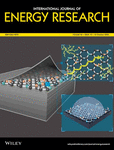Improving the photoelectrochemical performance of porous anodic SnOx films by adjusting electrosynthesis conditions
Funding information: Narodowe Centrum Nauki, Grant/Award Number: 2016/23/N/ST5/01579; National Science Centre, Poland
Summary
A comprehensive characterization of photoelectrochemical (PEC) properties of the nanoporous tin oxide (SnOx) films of different thicknesses and complex internal morphology is presented. Nanoporous SnOx layers were obtained by one-step anodic oxidation (anodization) of Sn foil in 1 M NaOH. Semiconducting films with a uniform diameter of ca. 50 nm were grown if the potential of 4 V was applied during anodization, and the layers with different thicknesses were synthesized by changing the duration of the process. Switching the potential between 2 and 4 V allows the formation of anodic films with segments of different channel diameters. The optimal anodizing duration for layers with uniform channels was found to be 50 minutes, which corresponds to the thickness of SnOx film of slightly above 6 μm. In the case of layers with segments of different channel diameters, the segment arrangement was found to be crucial for optimal PEC performance. Layers with the segment of narrower channels being in the contact with the current collector were found to exhibit enhanced photoelectrochemical performance compared to their counterparts with an opposite segment arrangement. This was mainly attributed to the favorable band arrangement facilitating the transfer of the photogenerated electrons to the external circuit as well as enhanced adhesion of the anodic SnOx layer to the current collector.
Highlights
- Nanoporous SnOx films were synthesized electrochemically.
- Layers with various morphologies were studied as photoanodes.
- The optimal thickness of anodic SnOx was found to be 6 μm.
- Enhanced PEC performance was observed for multisegment anodic films.
- The segment arrangement is crucial for optimal PEC performance.
CONFLICT OF INTEREST
The authors declare no conflict of interest. The funders had no role in the design of the study; in the collection, analyses, or interpretation of data; in the writing of the manuscript, or in the decision to publish the results.




